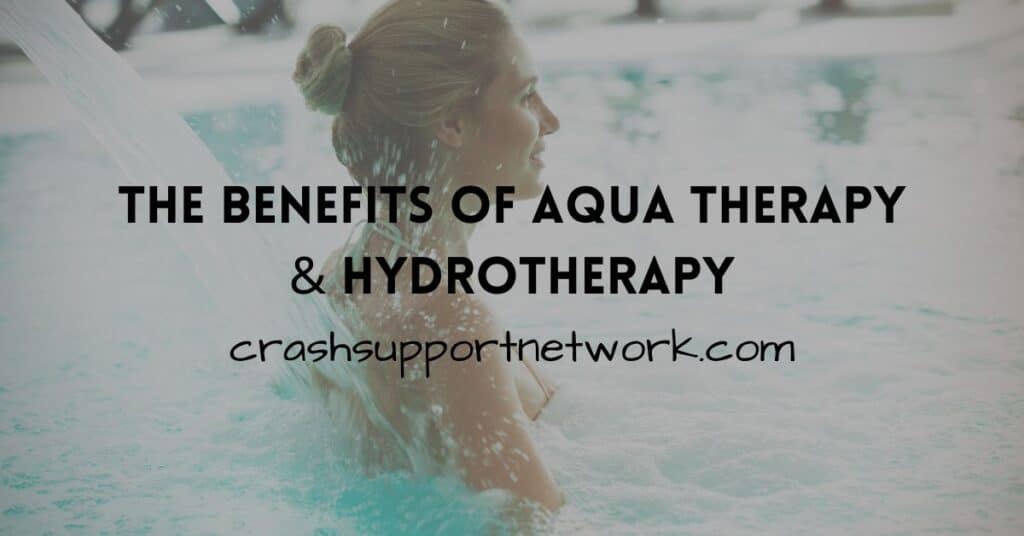
Aquatic therapy is physical therapy that takes place in a pool under the supervision of a trained healthcare professional. As I recovered from a motor vehicle crash, aqua therapy was recommended as part of my rehabilitation plan and although I was nervous and quite reluctant to get my broken body into a pool while healing from multiple injuries, I found it extremely beneficial.
Aquatic therapy is also known as water therapy, aquatic rehabilitation, aqua therapy, pool therapy or therapeutic aquatic exercise. Aqua therapy can improve your flexibility, balance, coordination and build muscle strength. Here are some of the ways that water can create an ideal therapeutic environment:
- Warm water provides a relaxing and soothing environment for aching joints and muscles.
- Water’s natural viscosity or resistance can be used for muscle strengthening and increasing rehabilitation progressions.
- Buoyancy allows for flotation and reduces the effects of gravity on injured or aching joints and muscles.
- Hydrostatic pressure supports and stabilizes your body. This allows you to perform exercises without a fear of falling.
- The respiratory muscles are forced to work harder in the water, allowing for a natural strengthening that benefits you long after the therapy session has ended.
What is Hydrotherapy?
When my massage therapist casually mentioned the word “hydrotherapy” to me and asked if I had ever used this type of therapy, I must admit I had no idea what she was talking about. I explained to her that I was definitely interested in anything that would benefit my recovery and could not wait to try it. Hydrotherapy uses the principles of water to allow exercise and to alter exercise intensity. Increased temperature and hydrostatic pressure promote an increase in circulation and flexibility. A hydrotherapy pool is a swimming pool specifically designed for providing hydrotherapy treatments. The main difference is the increase in temperature as a hydrotherapy pool is heated to around 35 degrees Celsius. This allows for you to fully relax while experiencing pain relief and encourages circulation. A hydrotherapy pool is usually rectangular in shape and may vary in depth to allow for walking as well as deep water work. It should be easily accessible and have a hoist available to lower in those who are not able to enter the pool themselves.
What Are the Benefits of Hydrotherapy?
Hydrotherapy can be very useful in treating many different types of soft tissue injuries from a motor vehicle crash. Benefits of hydrotherapy include:
- Pain relief;
- Reduction in muscle spasm;
- Increased joint range of motion;
- Strengthening of weak muscles;
- Increased circulation;
- Improvement of balance and co-ordination.
Because of the buoyancy of the water, hydrotherapy allows many individuals to exercise, where they wouldn’t be able to on land. The effect of this increased buoyancy and decreased gravitational force means that there is less stress on weight bearing joints such as the knees and hips and many movements can be performed in water much easier.
Hydrotherapy may be used to treat conditions such as arthritis, back pain, musculoskeletal conditions, fibromyalgia and chronic pain. There are so many different types of exercise that can be undertaken in water and the form of exercise prescribed will vary on your injury or condition(s).
Forms of Hydrotherapy
- Hydrotherapy can include anything from floating in the water and simply benefiting from the increased temperature and relaxation properties, to exercise sessions. The form of hydrotherapy used will depend entirely on you and your recovery;
- Many land based exercises can be adapted to use in the water. Walking in a pool is easier on the joints due to the buoyancy.
All exercises can be progressed by increasing the speed of the movement or the turbulence of the water. The buoyancy of the water can be used as either a tool to assist movement or to increase the difficulty of an exercise. Even if you are nervous about being in the water it’s worth trying hydrotherapy – I found the warm water soothed my aching joints immediately. The cycle of hot-cold temperatures forces my body to rest and improves my blood circulation, something that I desperately need.
S. Dawne McKay is a survivor of a horrific crash that changed her life forever. Dawne shares her personal journey as a Crash Survivor Blogger and also collaborates with crash survivors as Guest Bloggers allowing them an opportunity to share their stories. Dawne is also the author of the book, “Talk Crash to Me – What to Expect After Surviving a Collision and How to Manage Your Recovery” which is available for purchase on Amazon.
The Crash Support Network is a unique one-of-a-kind website consisting of an online support group, a crash survivor blog, a quarterly newsletter, “Sharing Our Recovery” as well as highly informative articles. Our website is based on relationship-building and puts the needs of survivors first by creating a helpful resource for victims and survivors of motor vehicle crashes.





